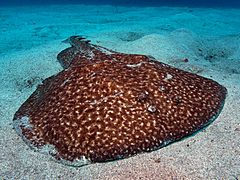Electric ray facts for kids
Quick facts for kids Electric rays |
|
|---|---|
 |
|
| Marbled electric ray (Torpedo marmorata) |
|
| Scientific classification | |
| Kingdom: | |
| Phylum: | |
| Class: | |
| Subclass: | |
| Superorder: | |
| Order: |
Torpediniformes
de Buen, 1926
|
Electric rays are a special group of rays. They are flat fish with cartilage instead of bones, like sharks. Their side fins, called pectoral fins, are very large. These rays belong to the scientific group called Torpediniformes.
What makes them super cool is their ability to make an electric discharge. This means they can create an electric shock! The shock can be small, like 8 volts, or very strong, up to 220 volts. It depends on the type of ray. There are 69 different species of electric rays, grouped into four main families.
These rays have special electric organs on both sides of their heads. These organs work like natural batteries. They use their powerful electric shock to stun or shock their prey. This makes it easier to catch food. They also use the shock to protect themselves from other animals.
Electric rays live in many different parts of the ocean. You can find them in shallow waters near the coast. They also live deep down, sometimes as far as 1,000 meters (3,300 feet) below the surface. They are slow swimmers and move mostly by wiggling their tails. Other rays often use their flat bodies to swim, but electric rays don't. They eat small invertebrates and tiny fish. They often hide under the sand or mud. When prey comes close, they use their electricity to stun and catch it.
How Electric Rays Are Grouped
Scientists group electric rays together because they all share a common ancestor. This means they are a "monophyletic" group. Scientists classify them to understand how they are related. Here is one way they are grouped:
- Family Narcinidae (these are called numbfishes)
- Subfamily Narcininae
- Subfamily Narkinae (these are known as sleeper rays)
- Family Torpedinidae (these are the torpedo electric rays)
- Subfamily Hypninae (sometimes called coffin rays)
- Subfamily Torpedininae
The word "torpedo" actually comes from a type of electric ray! It's from a group of rays in the Torpedininae subfamily, named Torpedo. This name comes from the Latin word "torpere," which means "to be stiff or numb." This makes sense, as their electric shock can make you feel numb!
Related pages
See also
 In Spanish: Rayas eléctricas para niños
In Spanish: Rayas eléctricas para niños

